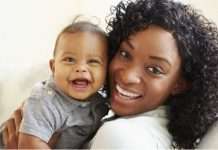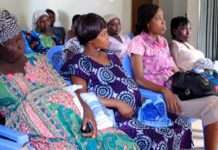(OBSERVATIONS AT THE NIGERIAN ARMY AUDIOLOGICAL CENTER, LAGOS)
(By Matthew Abe, BSc, BPharm.)
Caesarian Section is the procedure by which a surgeon cuts through the abdomen and uterus of a pregnant woman to bring out the baby alive. Here in Nigeria, vaginal birth is regarded as the normal mode of delivery. Whenever a Caesarian Section is required, it is almost always as a result of medical necessity. Such conditions include:
- Baby's head is too large for the mother's pelvis
- Baby is in a breech position
- Placenta previa
- Foetal distress during labor
- Very low birth weight of baby
- Mother has diabetes or other chronic conditions that might make vaginal delivery dangerous for her. (1.)
In the United States of America, 30% of births are by elective surgery. (1.) The incidence of hearing and speech impairment in children born by Caesarian Section gives cause for worry. 1 in 20 children born by C-S who had full Audiological investigation at the Nigerian Audiological Centre, Lagos were diagnosed with hearing and/or speech impairment. Screening of the new-born for hearing impairment is not a routine procedure in post-natal healthcare in Nigeria. Late detection of permanent congenital and early-onset hearing loss often has severe effect on linguistic, speech, cognitive and educational development in affected children.(2.) The aim of this article is to draw attention of members of the public to the incidence of hearing and speech impairment in children born by C-S so that the physician/ surgeon, audiologist and speech pathologist may be involved in measures to prevent or treat these unpleasant conditions in children.
METHOD
The case-notes of 650 pediatric patients were examined for their mode of birth and remarkable illness after birth including audiological impairment. All the babies were below the age of 4 years.
COMPLAINTS ABOUT THE BABY AFTER CAESARIAN SECTION
Overall, a cesarean section is an extremely safe operation. Most of the serious complications associated with cesarean sections are not due to the operation itself. Instead, the complications come from the reason for the cesarean section. For example, a woman whose placenta separates too early (placental abruption) may require an emergency cesarean section. In this case, problems arise primarily from the placental abruption—not the actual surgery.(1.) However, some children present with some pathological conditions after C-S birth. Some of these conditions are listed in Table 1.
Tablel. Audiological Conditions presented by patients who were delivered by Caesarian Section.
|
| O.M. | CS birth. Cannot talk at 5 years. Communicates via gesture. |
| A.C. | CS birth. Normal development. Fever at 3 years. Hospitalized, then, hearing loss. Communicates with gestures. |
| A.G. | CS birth. Diagnosed with Down Syndrome. Does not hear. |
| A.M. | CS birth. Neonatal jaundice treated with phototherapy. Convulsion at 2/2 years. Blabs. Communicates with gestures. |
| P.B. | CS birth. Did not cry at birth. Convulsion at 6 months. Not sitting at 1 year. Hard of hearing. |
| P.O.P. | CS birth. Inability to hear well Au. Delayed speech and language acquisition. |
| P.C. | CS birth. Frequent cold. Cannot talk clearly. |
| E.M. | CS birth. Inability to talk at 1 year. Poor developmental milestone. |
| E.K. | CS birth. Can't move right part of the body. Slow developmental milestone. Twin brother a still birth. Does not talk. |
| E.S. | CS birth. Delayed speech and language acquisition. |
| J.D. | CS birth due to prolonged labor. Retracted tympanum. Poor speech and language acquisition. |
| A.O. | CS birth. Infection at 8 days. Hearing loss after blood transfusion. |
| A.T. | Elective CS birth. Delayed speech and language acquisition. |
| O.O. | CS birth. Asphyxia. PDA at 2 months, treated with surgery. Communicates through signs. Could not make a complete sentence. |
| C.A. | CS birth. Meningitis 8 days after delivery. Incubated for one month. Received amikacin. Inability to hear or speak. |
| P.O. | CS birth. Sick after birth. Given antimalarial injection for 5 days. Difficulty in hearing and talking. |
| V.I. | CS birth. Convulsion. Restless. Does not play with other children. Cannot talk. |
| O.K. | CS birth. Low birth weight. Cannot talk nor hear. |
| Z.O. | CS birth. Adenoiditis. Steroid treatment. Inability to hear. Poor language acquisition. |
| B.O. | CS birth. Hole in the heart. Had surgery, then, stopped responding to sound. No speech. |
| J.A. | CS birth Low birth weight Asphyxia. Jaundice treated with phototherapy. Delayed developmental milestone. Lacks speech. |
| K.K. | CS birth. Measles at 4 years, then, hearing loss. |
CAUSES OF HEARING IMPAIRMENT
Infants delivered by C-S are three times more likely than babies delivered vaginally to fail their first hearing test. (4) The otoacoustic emissions test ( OAE ) in the new born is affected by fluids which are retained in the middle ear. Vaginal births may help dissipate middle ear fluids.(4)
In an Israeli study, 1,653 new-borns were evaluated. 1,170 were vaginal while the rest 483 were by C-S. 21% of the C-S infants failed the OAE test while only 7% vaginal births failed the test. The tests were conducted within 48 hours of birth.(4)
Viral Infections
Virus present at birth causes more than 10% of hearing loss in children. More than 10% of babies born with an infection of Cytomegalovirus (CMV) will suffer permanent hearing loss. CMV is the most common non-inherited cause of hearing loss in children.(5.) The source of infection is probably nosocomial. Among children who show virus symptoms, 1 in 3 suffers hearing loss, compared to 1 in 10 who show no symptoms. For symptomatic children, hearing loss will affect both ears. Children without symptoms usually suffer hearing loss in one ear. Infection at surgery is more common than at vaginal birth. Hearing loss from CMV is severe to profound. It can develop over time and may vary as it progresses.
Effect of Epidural Anaesthesia
The effects of maternal lidocaine hydrochloride anaesthesia on the brainstem auditory evoked response in neonates born by C-S have been evaluated.(6) Significant delay has been noted in the central neural component of the ABR at 90 dB for the experimental versus the control. In a particular study, the mean wave IV intervals were prolonged when test was conducted at less than 4 hours when compared to findings at 48 hours or longer. The changes in the serial auditory brainstem-evoked response test occur after maternal lignocaine amount in neonates correlated with blood lignocaine concentrations.(6)
MEDICAL AND AUDIOLOGICAL INTERVENTION
Hearing screening at birth should be incorporated in post-natal healthcare in Nigeria. The traditional birth attendants, faith-based healthcare givers, maternity centers and hospitals should ensure that the new-born gets a hearing test before leaving their facility and every year after until at least 6 years old. Kids with hearing loss need hearing aids. If the hearing loss is profound, then a cochlear implant may be recommended.
An anti-viral vaccine is the ultimate goal of treatment. CMV can also cause brain damage and vision problem. Prevention is of utmost importance. The role of behavioral and educational interventions cannot be over-emphasized.
CONCLUSION
Hearing loss from birth prevents speech and language acquisition in the affected children. This is a big cause of worry for parents. In the cultural milieu in which we live, it is common to read non-natural meanings to this condition in children. It is pathetic when some parents hide such children in their homes feeling that there is nothing that can be done to remedy the situation. Such children obviously need to go to school and also to acquire some vocational skills. This writer has come across a twenty-four year old male who had no speech and was on hearing aid in both ears. The parents, who are university teachers, prepared him for a career in fashion designing and he made a success of his training. At the time you are reading this article, the young man may be preparing for his wedding. In his sign language and lip-reading, he made it known to his parents it was time to marry.
REFERENCES
- https://www.nichd.nih.gov./obstetrics
- ibid
- asha.org/public/hearing/effects of hearing loss on development.
- healthday.com
- com/PED/topic544.htm
- J Pharm Bioallied Sci 2011 Jan-March 3(1) 135-141.













